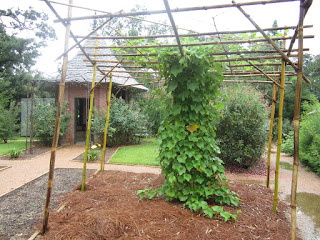Surviving this "Winter' has been hard going in the vegetable gardens. Annuals have suffered miserably from the wind and lack of rain. I've been hand watering just so I can keep the plants alive.
Since there has been no grass a'growing there has been no a'mowing, so I've not had grass clippings on hand to mulch with for months. To make do, I've been, methodically collecting junk mail to serve as my primary mulching material.
After a few weeks of collecting newspapers and catalogues from neighborhood roadsides I've got the routine down pat and have recoated my whole garden with a carpet of paper.
While I'm paper-in-the-garden obsessed -- being a dedicated junk mail gardener -- I surprised myself how effective slapping down even more paper can be for retaining and protecting the goodies underneath and, of course, suppressing weeds.
I'm all for that.
(See a weed: throw some wet paper over it.)
Slapped down wet, over the first few days it's a good idea to hose the paper often so that it truly settles. To aid the process, and to weigh it down against the wind, even a light sprinkling of whatever vegetive mulch you have will do. Twigs, sticks, old pieces of clothing, pulled weeds, bush trims -- whatever -- just throw what ever you've got on top. Of course the more 'real' green mulch you have the more aesthetic the landscape. A bale of hay, for instance, will go a long way lightly sprinkled over newspapered garden beds.
 |
| My trellis in its early days |
So with the mulching taken care of -- and a new routine and hobby it is too (maybe as a ritual a couple of times each year) -- I planted up big as soon as we started to get some rain.
Beans Beans Beans
Since I already had my trellis in situ and my Choko vines were already enlivened and climbing over it , I've been planting a mix of climbing beans under neath. I didn't want to rely on my old method of training the beans up knotted clothing because it proved a cumbersome ascent for them and the cloth was always too flappy and most climbers didn't take to the fabrics as preferred perches.
Instead I've trimmed wire mesh into narrow drops that fall from the trellis tops to the ground. I slide a stick -- any longish stick(bamboo is good) -- along most of the length to hold the ladder upright and against the wind.
They are completely mobile so as soon as bean sticks its little seedling head above the soil I can drop a ladder within its reach. Because they are made from flexible wire with a (easily slid) stick as a backbone, the ladders are effortlessly bent to shape or angled in diagonals to reach wherever the target plant is located.
And the beans love their new ladders. I reckon that after each growing season all I may need to do is cut the bean stork at ground level and move the ladder elsewhere -- even with its vegetation still attached.
Too easy.
I suspect that a similar technique may suit tomatoes -- support them from above rather than from below.
Watering via terracotta potting
In other snippets, I've managed to collect even more terracotta wine holders and these have proven a very efficient means of irrigating the garden.
The hype may indeed be true.
While my dogs (or the crows) will knock the lids off them -- the only drawback I've had with them is that once 'opened' small cane toads jump into the water filled tube and can't get out. So while they make great cane toad traps evicting the toads to freezer heaven is a difficult exercise.
Nonetheless, I'm hoping that by combining terracotta pots with my skills in tench mulching with paper -- I should be able to colonise a section of garden that now struggles for moisture as it is all sand. I've thrown over it a load of wood chips but the area needs a lot more attention if plants are going to thrive there. Among it all I have trenches packed with newspapers (and whatever) which have been embedded there for over 12 months and the sand is turning into soil.
I'm now planting out a lot of lemongrass in this area so that I can grow more of my own mulch. Lemongrass grows a superb mulching material with its stems that begs to be harvested at least twice per year.




















